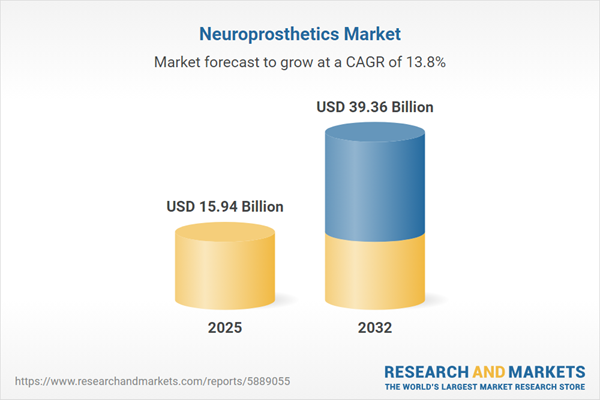Speak directly to the analyst to clarify any post sales queries you may have.
The neuroprosthetics market is rapidly evolving, shaped by ongoing digital transformation, changing regulatory environments, and greater reliance on advanced medical devices in neurological care. Senior leaders require reliable, concise market intelligence to inform decisions in this shifting landscape.
Market Snapshot: Neuroprosthetics Market Size and Growth
The neuroprosthetics market is on a robust growth trajectory, with revenues anticipated to progress from USD 14.02 billion in 2024 to USD 15.94 billion in 2025 and projected to reach USD 39.36 billion by 2032. This growth, reflected in a compound annual rate of 13.76%, is led by clinical adoption of sophisticated prosthetics, increased integration with digital health systems, and regulatory advances that foster both innovation and secure product introduction. Market participants are re-examining go-to-market approaches and emphasizing long-term value in an environment marked by swift technological and clinical advancement.
Scope & Segmentation of the Neuroprosthetics Market
- Product Types: Implantable neuroprosthetic devices address sensory deficits, motor rehabilitation, and neurostimulation needs. Nonimplantable solutions—including wearable aids, smart orthoses, rehabilitation equipment, and adaptive software—expand options for individualized neurological management across diverse patient groups.
- Applications: Solutions target restoration and enhancement of sensory and motor function, support for patients with severe communication limitations, and streamlined neurorehabilitation in both clinical and home settings.
- End Users: Key stakeholders include hospitals, specialist rehabilitation clinics, home-care organizations, and research institutions, each deploying neuroprosthetic tools to address unique care and research challenges within neurological health.
- Modalities: Innovations span myoelectric prosthetics, intracortical systems, peripheral implants, and noninvasive neural interfaces such as EEG and surface EMG, facilitating personalized interventions in various care environments.
- Regions: Regulatory policies, reimbursement strategies, and clinical infrastructure differ across the Americas, Europe, Middle East and Africa, and Asia-Pacific, shaping how technology is adopted and shared regionally.
- Key Companies Analyzed: Major contributors such as Medtronic plc, Abbott Laboratories, Boston Scientific Corporation, Cochlear Limited, LivaNova PLC, Nevro Corp., MicroPort Scientific Corporation, NeuroPace Inc., Second Sight Medical Products Inc., and Bioness Inc. influence competitive dynamics and innovation directions within the sector.
Key Takeaways for Senior Decision Makers
- Artificial intelligence is customizing neuroprosthetic solutions and optimizing clinical workflows, directly supporting improved patient outcomes and operational efficiencies across care settings.
- Evolving regulatory frameworks allow for faster, compliant market introduction, enabling firms to remain responsive to new standards and industry shifts.
- Advancements in device materials are enhancing adaptability, increasing user comfort, and allowing for greater customization based on individual patient needs.
- Diversifying supplier networks and leveraging predictive logistics support supply chain integrity, helping manufacturers and care providers anticipate risks and maintain business continuity.
- Collaboration across technology developers, healthcare providers, and manufacturing partners is speeding product rollout and streamlining the path from R&D to daily practice in neuroprosthetic care.
Tariff Impact on US Neuroprosthetics Supply Chains
- Tariffs on key inputs such as microcontrollers and electrode arrays are prompting US-based firms to revise procurement and sourcing strategies, promoting advanced risk management and resilience planning.
- Investment in national supplier networks and facility growth equips organizations to address macroeconomic volatility and reduce reliance on external sources.
- Cross-regional partnerships and alliances bolster access to critical components, enhancing adaptability amid ongoing changes in global trade patterns.
Methodology & Data Sources
This report is grounded in insights from clinical leaders and prominent industry manufacturers. Information is derived from peer-reviewed research, official regulatory communications, and authenticated company disclosures. Engagement with sector stakeholders and clinical trial data informs a balanced view of neuroprosthetics market dynamics and ongoing developments.
Why This Neuroprosthetics Market Report Matters
- This report provides senior executives with precise segment-level data, empowering strategic planning, timely investments, and robust risk management across business units.
- An integrated review of technology adoption, regulation, and partnership models equips organizations to design adaptive strategies and sustain market relevance in a changing environment.
- Actionable insights help procurement and technology leaders safeguard operational agility and reinforce supply chains, supporting enterprise resilience despite market and regulatory shifts.
Conclusion
Organizations leveraging actionable data and agile market strategies will be able to anticipate regulatory changes and drive steady advancement in the neuroprosthetics market.
Additional Product Information:
- Purchase of this report includes 1 year online access with quarterly updates.
- This report can be updated on request. Please contact our Customer Experience team using the Ask a Question widget on our website.
Table of Contents
3. Executive Summary
4. Market Overview
7. Cumulative Impact of Artificial Intelligence 2025
Companies Mentioned
The companies profiled in this Neuroprosthetics market report include:- Medtronic plc
- Abbott Laboratories
- Boston Scientific Corporation
- Cochlear Limited
- LivaNova PLC
- Nevro Corp.
- MicroPort Scientific Corporation
- NeuroPace, Inc.
- Second Sight Medical Products, Inc.
- Bioness, Inc.
Table Information
| Report Attribute | Details |
|---|---|
| No. of Pages | 188 |
| Published | October 2025 |
| Forecast Period | 2025 - 2032 |
| Estimated Market Value ( USD | $ 15.94 Billion |
| Forecasted Market Value ( USD | $ 39.36 Billion |
| Compound Annual Growth Rate | 13.7% |
| Regions Covered | Global |
| No. of Companies Mentioned | 11 |









